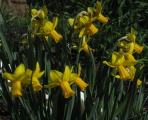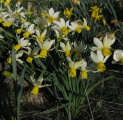It has been a good year for seed on the narcissus/pseudonarcissus triploids, mostly crossed with tetraploids. Hopefully, in a few years, it will be clear how effective this policy is for producing fully fertile tetraploids.
A sibling of Glenbrook’s Sad Husser has set seed, and also a few seeds have come from a number of my own Pink China x (Swagger x cyclamineus) including 07_18D. Also with pink genetics, a seedling that is Rheban Charm x (Swagger x cyclamineus) set seed.
A Terminator x cyclamineus seedling was belatedly given a selection number (12_00D) because it is a vigorous plant and a reliable seeder. Its sibling 10_04D also set seed for the first time.
A pleasant surprise was 14_19D (Tracey x [Foundling x (The Little Gentleman x Dear Me?)] The pollen parent is a fertile tetraploid and it appears that 14_19D is also a very fertile tetraploid.
I was given a flower of Little Azzy. It too looks like it will be a useful flower for breeding tetraploids.
Not division 6, but related, an alpestris triploid set seed for the first time.
In the diploids, several alpestris x poet diploids were crossed with diploid poets and a huge amount of seed was produced.
Closer to division 6, a cyclamineus x Cantabile seedling (06_50D) set seed to 12_37D poet x (jacetanus x alpestris). Unfortunately and unsurprisingly 12_37D is not sun-proof.
These results make it fairly clear that there is no difficult fertility barrier between the narcissus and pseudonarcissus species.








